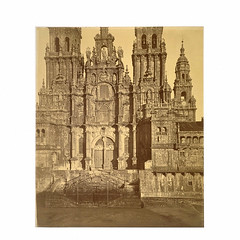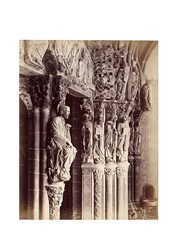By Stuart Frost
I have to confess that I am guilty of claiming one particular object of being my favourite, and then next week I declare something else to be the greatest artefact in the V&A’s collections. Hopefully you’ll overlook my inconsistency. This week though I am writing about an object for which I do have unique affection, and it isn’t even the real thing!
The V&A collections include a vast nineteenth-century plaster copy of the Portico de la Gloria from the cathedral of Santiago de Compostela. Pilgrims entering the cathedral today via the main entrance in the west façade pass through the Portico de la Gloria, a masterpiece of late twelfth-century architectural sculpture. The photograph reproduced to the right shows the vast Baroque façade of the cathedral behind which the medieval masterpiece is now hidden. Click on the image for more information about the photograph.
The V&A’s plaster copy of the Portico was created in 1866 when casts were taken from the original by a team of specialists commissioned by the Director of the South Kensington Museum (as the V&A was then known). The Portico is now acknowledged as one of the great works of art of any time and place, but this wasn’t always the case.
Before 1865 detailed accounts of the Portico were not available and it had recieved little attention. The displaying of the plaster cast copy of the Portico at the South Kensington Museum, and the publication of a series of photographs by Charles Thurston Thompson, played a crucial role in raising public and scholarly awareness of this great work. Where as a sculpture like Michelangelo’s David has long been admired and appreciated, the medieval Portico languished in relative obscurity for many centuries.
In my last posting I wrote about the feast day of St James which was celebrated on the 25 July. The shrine of St James is in the cathedral of Santiago de Compostela and the saint has a prominent position on the Portico de la Gloria welcoming pilgrims to the church. Vast numbers of pilgrims of all ages and from diverse backgrounds still tread along the long route to Santiago each year, a route which people have been following for over a thousand years and which shows no sign of waning in popularity.
 I confess that St James and Santiago de Compostela have been on mind recently because I’m looking forward to my next holiday, the flights for which I booked a few weeks ago. Later on this summer I’ll be meeting up with a few friends in St Jean-Pied-de-Port, before walking across the Pyrenees into Spain following the pilgrim route to Santiago. Unfortunately I don’t have enough leave to be able to walk all the way in one go. So I’ll get as far as I can in ten days this year, and then pick up where I left off next year!
I confess that St James and Santiago de Compostela have been on mind recently because I’m looking forward to my next holiday, the flights for which I booked a few weeks ago. Later on this summer I’ll be meeting up with a few friends in St Jean-Pied-de-Port, before walking across the Pyrenees into Spain following the pilgrim route to Santiago. Unfortunately I don’t have enough leave to be able to walk all the way in one go. So I’ll get as far as I can in ten days this year, and then pick up where I left off next year!
To search the V&A’s collections for objects which have a connection with St James or Santiago de Compostela visit Collections Online
If you’re interested in finding out more about following the pilgrim route to Santiago de Compostela you may find the website of the Confraternity of St James
I followed the pilgrim route myself this year and it was a life changing experience; the scenery of the Pyrenees was breathtaking, the ruins, the 18th century splendour and the quite unique ‘pilgrim passport stamping’ all contributed to the very unique nature of my journey. It’s not for everybody — my wife and I were very dedicated, but if is your true desire and calling to do so, then I would recommend it.
I dont see any coment regarding how the originals colours from the Portigo da Golria was removed from the priceless piece of art when the “well prepared” people of the V&A museum removed the cast from this unique piece of Art. Making impossible for the new generations to see this gate at the city of Santiagos cathedral as it was in the past.
There are may items in the V&A that I have no idea how they were made.
There is a really nice demonstration of how the copy of the small statue of the “Seated Girl” was made. It really makes sense for an object that can be turned around as it is prepared.
However for the Portico de la Gloria, I have no idea how the casting of this scale of work was actually carried out? I wonder if there are any photographs showing how such a massive task was carried out.